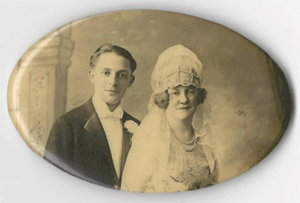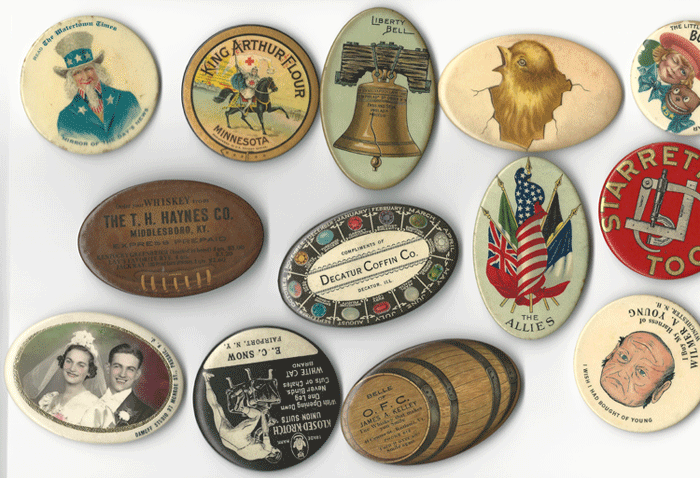|
Collecting Pocket Mirrors: Miniature Treasures of Design and Nostalgia
| By Cynthia Maris Dantzic
Posted December 2014
|
 |
Often hidden among larger (and costlier) items at flea markets, collectible shows and antique shops are small oval and round celluloid-backed pocket mirrors, worthy additions to your list of ŌĆ£must findŌĆØ treasures.
|
These tiny mirrors, no more than three inches in length, are often charming examples of graphic design in miniature, much easier to store and display than the posters, produce-crate labels, enameled advertising signage, or the actual products they often illustrate.
As early as the late 19th century, shopkeepers presented these useful and decorative items as complimentary souvenirs, often in a basket or tray on their countertops, not only as a constant reminder of their establishment, service or product, but also as a useful addition to miladyŌĆÖs purse or a gentlemanŌĆÖs pocket. Long before Andy Warhol immortalized the CampbellŌĆÖs Soup can as an icon of Pop Art, tiny circles of celluloid pictured these on the face of round pocket mirrors, with the addition of period type announcing the price (10 cents!), thus blurring the distinction between ŌĆ£fineŌĆØ and ŌĆ£commercialŌĆØ art. I actually paid $3 for mine a number of years ago, after debating its high cost!
|

The bride is wearing a wedding-cake bridal headdress. This pocket mirror was recently found at a flea market and purchased for $4.
|
Earlier, when I began to look for pocket mirrors, the price had ranged from 25¢ to a dollar or two, and they may still be found on occasion as low as $5, although certain rarities now bring up to $500 or even more. A number of early 1903-era Coca-Cola beauties, featuring stylish ladies of the period gracefully holding a glass of the ubiquitous thirst-quencher, are in this range. These are hard to come by, though imitations, reproductions, (yes, call ŌĆÖem fakes) are relatively common.
There are a number of ways to detect and identify these forgeries. Among the most easily observed discrepancies between the real and not-real are the absence of the makerŌĆÖs name on the mirrorŌĆÖs rim and the appearance of large Ben-Day-type dots seen under magnification, indicating a screen-printed copy of the original.
Advertising has been only one of the many subjects of what is hoped to become your newest collecting passion. Another category is matrimony. At weddings, portraits of the bride and groom on pocket mirrors were given as keepsakes starting in the early 1900s. These are easily found, often for between $5 and $15. To me, the images of brides, particularly their changing headdresses and veils, provide a delightful, often amusing, history of styles and fashions over the decades. Some seem to rival the wedding cake itself.
Of course, other family-related events have been recorded and preserved on these portable, reflective miniatures. For the younger set, baby portraits were popular, as well as images of children at christenings, confirmations and bar mitzvahs.
At the other side of the lifecycle, I have a charming double portrait of a couple on their 50th wedding anniversary with a silvery border, and I have several 25th anniversary mirrors. Military portraits are frequently to be found, particularly those made during the Second World War, when patriotism was at its height. There are many mirrors with pre-printed edge-images of the flag with an open area in the center for a portrait of the familyŌĆÖs serviceman or woman. I have a particularly appealing pair of these, with a soldier centered on one, and his Mom (sheŌĆÖs tooŌĆ”matureŌĆ”to be his sweetheart) on the other, looking rather sad.
The snapshot of family events was a common subject for mirrors in the 1930s and ŌĆś40s, and I have seen, and even acquired, a number of these featuring old-style bathing suits, straw hats and groups of young people with their arms around each otherŌĆÖs shoulders, grinning into the camera after an evening ofŌĆ”whatever, as the kids say.
Historic sites are a fine subset for your collection, from the Statue of Liberty (with or without an ad for a drugstore or other merchantŌĆÖs shop), the Capitol, Washington Monument, Niagara Falls (from many viewing angles), any number of forts, state capitol buildings and birthplaces of the famous, to equestrian statues of many generals and other heroic individuals.
You might look for shaped mirrors which exploit their round or oval format, turning the entire object into a tiny football, basketball, old-style vinyl record, cookie or egg. For example, I have a charming white oval mirror with a thin crack seeming to run down its center and a yellow chick with his little beak and eye apparently emerging from the interior. I will admit that these shaped mirrors are among my favorites. The beer keg and whiskey barrel provide particularly successful three-dimensional illusions for mirrors. One of the diminutive mirrors shaped like an old-style records bears a red RCA label which reads ŌĆ£Edison,ŌĆØ a special treasure.
Not a shaped mirror, but one on a related subject, features the famous Victor dog with its head tipped as it listens to ŌĆ£his masterŌĆÖs voiceŌĆØ on an early recording device, the historic phonograph.
There are so many specific subject areas for you to seek as your collection grows. General topics such as ŌĆ£productsŌĆØ can include specific sub-categories: toiletries (talcum powder was a favorite and hair products of all sorts, with the most amazing hairstyles and moustaches); potables (yes, you will see many beer, whiskey, barroom and soft drink graphics); tools and machinery (from large farming equipment to tiny nails); clothing (from boots and shoes to menŌĆÖs suits, womenŌĆÖs undergarments and hats); medicinals (from Lydia PinkhamŌĆÖs ladiesŌĆÖ pills to various cures for every imaginable ailment); and yes, thereŌĆÖs more!

You may want to search for specific subjects such as: animals (dogs, cats, birds, farm critters); transportation (ships, trains, bicycles); theatrical personalities (Elvis, Rita Hayworth, Marilyn); specific products (Cracker Jacks, BeemanŌĆÖs gum, Buster Brown shoes, Lava soap); political (FDR, many local candidates for office); holidays (Christmas tops the list); or pre-celluloid paper-backed specimens with many products no longer available. This latter can be particularly inexpensive but delightful, advertising such long-vanished products as roller tray trunks, horse blankets, grate bars for coal, or facilities such as H. FischerŌĆÖs Pool Room in Niagara Falls, or Ross Hatter & Shirter.
If you are just beginning to search for pocket mirrors, among the most frequently seen examples at flea markets are those with round gemstone-edged borders, often encircling an ad for a jewelry store (with or without a large picture of a diamond or diamond ring) or other pictorial subjects. The inverted image shows the smiling face of a satisfied customer seen in one direction and when held upside down, the frowning scowl of the disappointed fellow who purchased the product from an inferior competitor. ŌĆ£I wish I had bought of Young,ŌĆØ says the caption on one.
One specialty, known as ŌĆ£dexterityŌĆØ toys or games, features an image with several indentations into which one tries (and tries) to fit tiny balls by shaking gently and turning the piece. Favorite subjects for these are: the teeth of animals: smiling but odd-looking people; the eggs of various kinds of poultry; balls of different sports, such as tennis or billiards; and eyes of all sorts. My favorite of these features a ladyŌĆÖs high-topped and high-heeled black boot with five tiny black balls to be fitted into five little buttonholes. It is a maddening but satisfying effort.
If you are seriously determined to build a collection of these delightful miniatures, but are unsuccessful at first in your perusal of flea markets, garage sales or antique shops, you may want to look into the offerings of HakeŌĆÖs Americana and Collectibles. You can always find a nice selection of pocket mirrors in their catalogue or auction listings and at reasonable prices.
Once you have amassed a small treasury of mirrors, you may find it convenient and easy to store and display them in a number of easily obtained containers. Jewelry and coin-collectorŌĆÖs trays with individual sections lined in soft felt are ideal. Old-style spool thread cabinets are treasures in themselves and can hold a large collection in their many subdivided drawers.
Only the length of this article keeps me from adding many more details. I would be glad to pursue further. If you would like to know more about the history, preservation, storage, or condition issues related to pocket mirrors, a letter to the editor will be sure to find me, and I do answer every one.
And yes, IŌĆÖd love to see a photo of your grandparentsŌĆÖ wedding mirror!
----------------------------------------------
Cynthia Maris Dantzic is a Senior Professor of Art at LIU Brooklyn, a campus of Long Island University.
She exhibits work in a variety of mediums and is the author of nine art-related books. The newest, 100 New York Calligraphers, will be released this spring. Detailed clues about fakes, and other material about pocket mirrors can be found in her recent book, Antique Pocket MirrorsŌĆöPictorial & Advertising Miniatures, which presents life-size images of about 700 of these beauties in full color on heavyweight glossy paper, presenting the look and feel of the actual objects they depict. It may be purchased through Amazon or directly from the publisher, Schiffer Publishing Ltd.
|